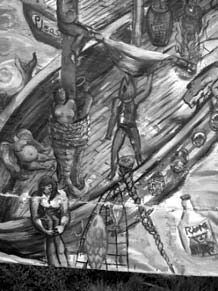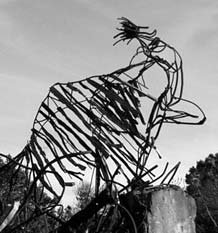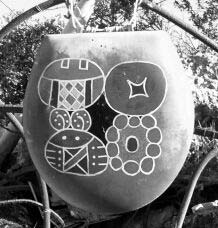 |
|
|
| Art at the Albany Landfill | ||
|
March 2003
The materials are simple: paint, large pieces of discarded wood, time and creativity. Unfortunately, the outdoor art exhibit at the Albany Landfill will soon be removed to make way for the expanded Eastshore State Park, which the California State Park and Recreation Commission unanimously voted for on December 6, 2002. Located next to Golden Gate Fields, the Albany Landfill has undergone many changes since its creation prior to WWI. Originally intended for an urban and industrial complex to support naval operations, it became a general dumping ground after WWII and continued as such until 1984. Although various organizations (including the Santa Fe Railroad and the Army Corps of Engineers) proposed plans to further fill the east bay, community organizing in the 1960s prevented more alteration to the shoreline as well as the construction of a large shopping center nearby. Out of the ensuing lawsuit by Santa Fe Railroad "came the famous California Supreme Court decision that stated Ś...tidal lands of the State which still had tidal action over them were held in public trust and could only be used for specific public trust purposes related to navigation or for protecting habitatą" (www.eastshorestatepark.com.) Santa Fe continued to try and develop the land, consistently meeting with public opposition and lengthy city planning processes. It was not until 1997 that State Parks and Eastbay Regional Park District successfully purchased the site from Santa Fe Railroad.
The plan adopted by the Parks Commission in December includes a smaller area for off-leash dog walking, athletic fields, trails, and a boat launch. The Sierra Club applauded parts of the plan, including moving the athletic fields from natural habitat to an already paved section currently owned by Magna Entertainment and a study of the effects of boats on migrating bird patterns, which could halt plans for the boat launch. Off-leash dog walkers, whose portion of the park has been reduced to 20%, and the local artists, who have no part in the new park, are unhappy.
Currently, the landfill is still being vigorously used by both artists and dog owners. On sunny days, it seems someone with a dog or two is always entering the park. Along the north shore, the huge entrance to the row of plywood paintings stands tethered by wires. A rebar angel leaps up from its concrete perch over walls made of bicycle pieces and seashell mobiles. The implementation of the park design isnąt likely to take place soon, but those who would like to walk through the outdoor art gallery with their four-legged friends should take advantage of sunny days to visit this local masterpiece before it becomes a memory.
|
|
|

 While
the war over the park raged in meetings and court hearings, the
park reverted to a more natural habitat. Blackberries and pampas
grass covered the plateau, while huge chunks of concrete and twisted
rebar rear up from the actual shoreline in surreal contrast to the
surrounding park atmosphere. Meandering dirt trails crisscross through
the pampas stands and scatterings of trees. Wildflowers, from native
species to a solitary pink rose bush, bloom wildly across the park.
By the 90s, the park had become a refuge for local homeless populations
who were able to set up more or less permanent tent homes. They
were cleared out in 1999, after numerous complaints ranging from
general conditions (raw sewage, stray dogs) to attempted murder.
More recently, off-leash dog walkers and a group of artists going
by the name "Sniff" have made the landfill their home away from
home.
While
the war over the park raged in meetings and court hearings, the
park reverted to a more natural habitat. Blackberries and pampas
grass covered the plateau, while huge chunks of concrete and twisted
rebar rear up from the actual shoreline in surreal contrast to the
surrounding park atmosphere. Meandering dirt trails crisscross through
the pampas stands and scatterings of trees. Wildflowers, from native
species to a solitary pink rose bush, bloom wildly across the park.
By the 90s, the park had become a refuge for local homeless populations
who were able to set up more or less permanent tent homes. They
were cleared out in 1999, after numerous complaints ranging from
general conditions (raw sewage, stray dogs) to attempted murder.
More recently, off-leash dog walkers and a group of artists going
by the name "Sniff" have made the landfill their home away from
home.  The
resolution sent to the Parks Commission came after a long period
of debate and public input which involved interests as varied as
BMX bikers, dog owners, environmental groups, local Little League
teams, windsurfers, and artists. Several commissioners celebrated
the community process that led to the adopted park plan, but the
dog walkers and artists both stated that, regardless of significant
public input in their favor, their interests were not considered
when the plans were drawn.
The
resolution sent to the Parks Commission came after a long period
of debate and public input which involved interests as varied as
BMX bikers, dog owners, environmental groups, local Little League
teams, windsurfers, and artists. Several commissioners celebrated
the community process that led to the adopted park plan, but the
dog walkers and artists both stated that, regardless of significant
public input in their favor, their interests were not considered
when the plans were drawn.